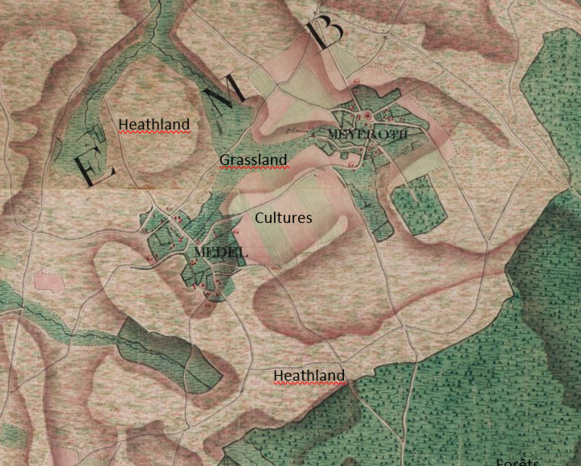Project background
As recently as 150 years ago, the villages of the Haute-Ardenne region were essentially dependent on woodland and extensive livestock farming, as the soil was not rich enough for cultivation. As a result of these agropastoral practices, which favoured itinerant herds of sheep and cattle, the landscapes of eastern Belgium gradually evolved into vast expanses of moorland and grassland.

The figure above shows the spatial organization of the land around two Ardennes villages as it was at the end of the eighteenth century. Around the village itself, with its cluster of houses, we find orchards and pastures, sometimes fenced off and bordered by hedges, which were used by the animals at night and in winter. Beyond that, a few crops were fertilized with animal droppings collected in and around the village. Then there were the vast areas of moorland where the animals grazed during the day, under the guidance of a herdman. So it was mainly the village animals that roamed these moors. These areas were regularly interspersed with valleys, where specific irrigation techniques (abissage) were used to optimize the use of hay meadows.
It should be noted, however, that these villages did not remain isolated and that there were many exchanges between them. In addition, the development of the wool industry in the Vesdre valley in the early 19th century had a major impact on all the neighboring Ardennes plateaux. The need for wool led to an increase in the size of sheep flocks, which required vast areas of pasture in order to thrive. In 1806, the village of Meyerode had 1,675 "woolen animals" and, in this region, the average per village was more than 2,000 animals. These figures show the scale of this local economy and of these herds, which required space to feed!
These moors were not used exclusively for grazing, but were farmed on a 15-20 years cycle. Despite extensive grazing, the heathland became overgrown and had to be thinned out regularly. It was then cleared of trees and/or bark so that it could be cultivated for one or two years, before being left uncultivated and once again subjected to itinerant grazing.
In the middle of the 19th century, these farming methods became less profitable and many areas were converted to hay meadows or pastures, thanks to mineral amendments and the use of fertilizers. On the other hand, areas that could not be converted to more mechanized farming were abandoned and/or heavily replanted with conifers. This resulted in the fragmentation and almost complete disappearance of the ancestral semi-natural habitats and the flora and fauna associated with them.
The LIFE Nardus project was born of the desire to restore and connect these threatened semi-natural sites in the eastern Ardennes.



